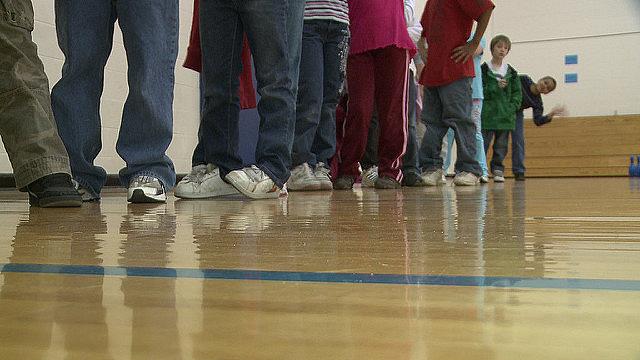Amid conflicting reports, what’s the actual story on childhood obesity?

Elementary school students in Moberly, Missouri line up for exercise time.
There has been a glut of headlines on childhood obesity this week, prompted by a new study that seems to cast doubt on earlier reports of drops in early childhood obesity rates. Accompanying the news is an undercurrent of futility — have a decade’s worth of efforts to curb obesity rates really been for naught?
“Childhood Obesity Rates Are Still Rising,” TIME announced, while NPR opted for a little more nuance: “Plateau But No Decline: Child Obesity Rates Hold Steady.” The Los Angeles Times’ Melissa Healey succinctly summarized this latest narrative twist in her alliterative lead:
“A handful of preliminary studies in recent years has raised hopes the epidemic of U.S. child obesity has stabilized or reversed. But new research finds continued growth in our kids’ girth, suggesting that self-congratulation would be premature.”
The study, which analyzed data from the National Health and Examination Survey (NHANES) from 1999 to 2014, flatly concludes: “There is no evidence of a decline in obesity prevalence in any age group, despite substantial clinical and policy efforts targeting the issue.”
That’s obviously a rather different conclusion from the one readers were offered in 2014, when The New York Times carried the headline, “Obesity Rate for Young Children Plummets 43% in a Decade.” Most health journalists are used to research whiplash by now, but it’s still worth asking what’s going on here. Was the earlier data off? Is someone’s calculator on the fritz?
It turns out you don’t have to look much further than the same issue of the journal Obesity in which the new study was published for another very useful perspective on these matters. The one-page commentary from William H. Dietz of George Washington University offers a salutary reminder that the real story is usually a little more complicated than the headlines — and even the studies themselves — suggest.
As Dietz notes, the data used in this newest study from Duke University’s Asheley Cockrell Skinner and colleagues were also part of the 2014 report published by the CDC’s National Center for Health Statistics in JAMA, by Cynthia L. Ogden and colleagues. (That earlier report was the basis for that The New York Times article, which cited “a 43 percent drop in the obesity rate among 2- to 5-year-old children over the past decade.”)
So how did the same pool of data find its way into a new study, which finds no such drop in obesity prevalence among the very same group of young children, or any other age range for that matter?
According to Dietz, the devil is in the data: “Although the two studies appear contradictory, neither analysis is incorrect — it all depends on whether you start with the 1999–2000 or 2003–2004 data,” he writes.
This newest study starts with 1999-2000 data, while the earlier research starts with 2003-2004 data. That, apparently, is the difference between finding obesity prevalence dropped 43 percent over a decade among 2- to 5-year-olds, and finding no improvement at all.
If you’re wondering which of these versions will carry the day, Dietz does further note that the CDC’s 2014 findings have one other point in their favor: They’re supported by data from another source, called the Pediatric Nutrition Surveillance System. That data “showed significant declines in the prevalence of obesity among 2- to 4-year-old children in 18 states,” he writes.
Those complexities of data gathering don’t often make the news cut (CBS News and Parent Herald do cite Dietz’ objections, to their credit). Instead, the narrative that prevailed tended towards “new study wipes out earlier glimmers of hope on early childhood obesity.”
But this new study does offer plenty of disheartening news elsewhere, particularly when it comes to severe obesity. As of 1999/2000, less than 1 percent of kids and teens ages 2 to 17 had such levels of obesity, which is characterized by a body mass index of 40 or above. By 2013/2014, 2.4 percent of kids and teens were severely obese. If you just look at teens alone, the numbers rise from 6 to 10 percent over the same period.
So while obesity rates for young kids may’ve dropped a bit over the past decade, depending on your data source, the rates for teens are getting significantly worse. Kids who are already obese appear to be getting even more obese. That’s headline-worthy bad news in itself, and should help fuel a new discussion about why a decade’s worth of policies and investments aren't getting more traction in turning around this health crisis.
[Photo by KOMUnews via Flickr.]

